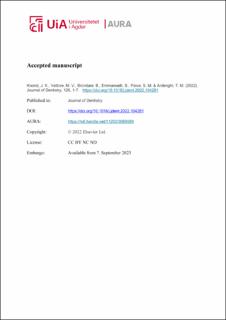| dc.contributor.author | Knorst, Jessica Klöckner | |
| dc.contributor.author | Vettore, Mario Vianna | |
| dc.contributor.author | Brondani, Bruna | |
| dc.contributor.author | Emmanuelli, Bruno | |
| dc.contributor.author | Paiva, Saul Martins | |
| dc.contributor.author | Ardenghi, Thiago Machado | |
| dc.date.accessioned | 2023-05-25T10:54:43Z | |
| dc.date.available | 2023-05-25T10:54:43Z | |
| dc.date.created | 2022-09-15T14:43:19Z | |
| dc.date.issued | 2022 | |
| dc.identifier.citation | Knorst, J. K., Vettore, M. V., Brondani, B., Emmanuelli, B., Paiva, S. M. & Ardenghi, T. M. (2022). Journal of Dentistry, 126, 1-7. | en_US |
| dc.identifier.issn | 1879-176X | |
| dc.identifier.uri | https://hdl.handle.net/11250/3068989 | |
| dc.description | Author's accepted manuscript | en_US |
| dc.description.abstract | Aim: To evaluate the impact of community and individual social capital during early childhood on oral healthrelated quality of life (OHRQoL) over a 10-year follow-up period. Methods: A prospective cohort study was conducted in the southern Brazil. Baseline (T1) data collection occurred in 2010 with preschool children aged 1-5 years. Participants were assessed in 2012 (T2), 2017 (T3), and 2020 (T4). OHRQoL was assessed using the B-ECOHIS at T1 and T2 and through CPQ8-10 at T3 and CPQ11-14 at T4. Community social capital was evaluated through the presence of formal institutions in the neighbourhood and individual social capital by social networks, both at T1. Demographic and socioeconomic characteristics were also evaluated. Multilevel Poisson regression analysis was performed to estimate the impact of social capital measures on OHRQoL. Results: Of the 639 children assessed at T1, 469 were followed at T2 (73.3% response rate), 449 at T3 (70.3% response rate), and 429 at T4 (67.1% response rate). Individuals living in neighbourhoods with the presence of social class associations at T1 had higher OHRQoL at T3 and T4. Individuals whose families visit friends and neighbours less than once a month or never at T1 had lower OHRQoL at T1, T3 and T4. Attending religious meetings less than once a month or never at T1 was associated with lower OHRQoL at T2 and T4. Conclusion: Social capital at the community level had a long-term effect on OHRQoL, especially during adolescence, while individual social capital levels impacted OHRQoL across the assessments. Clinical Significance: The findings indicate that psychosocial variables can impact OHRQoL, a fundamental aspect of clinical practice. | en_US |
| dc.language.iso | eng | en_US |
| dc.publisher | Elsevier | en_US |
| dc.rights | Attribution-NonCommercial-NoDerivatives 4.0 Internasjonal | * |
| dc.rights.uri | http://creativecommons.org/licenses/by-nc-nd/4.0/deed.no | * |
| dc.title | Impact of community and individual social capital during early childhood on oral health-related quality of life: a 10-year prospective cohort study | en_US |
| dc.type | Peer reviewed | en_US |
| dc.type | Journal article | en_US |
| dc.description.version | acceptedVersion | en_US |
| dc.rights.holder | © 2022 Elsevier | en_US |
| dc.subject.nsi | VDP::Medisinske Fag: 700::Klinisk odontologiske fag: 830 | en_US |
| dc.subject.nsi | VDP::Medisinske Fag: 700::Basale medisinske, odontologiske og veterinærmedisinske fag: 710 | en_US |
| dc.source.pagenumber | 7 | en_US |
| dc.source.volume | 126 | en_US |
| dc.source.journal | Journal of Dentistry | en_US |
| dc.identifier.doi | https://doi.org/10.1016/j.jdent.2022.104281 | |
| dc.identifier.cristin | 2052122 | |
| dc.relation.project | Conselho Nacional de Desenvolvimento Científico e Tecnológico (CNPq – process 160258/2020-0) | en_US |
| dc.relation.project | Fundação de Amparo à Pesquisa do Estado do Rio Grande do Sul (FAPERPGS – process 17/2551-0001083-3) | en_US |
| dc.source.articlenumber | 104281 | en_US |
| cristin.qualitycode | 2 | |

